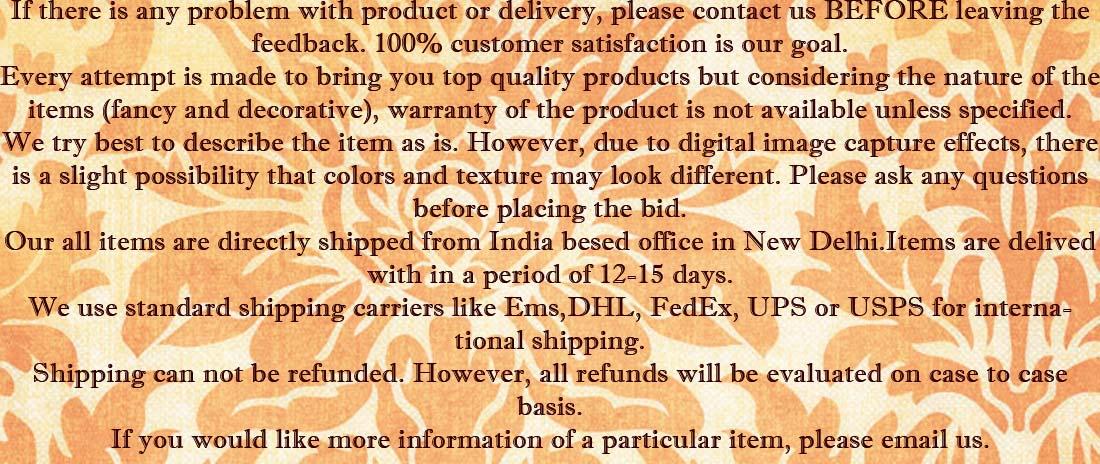|
Ethnic India Arts Bringing you a more than 70 years old VINTAGE INDIAN HEAVY HAND STICH SILK EMB FHULKARI BAGH SHAWL 48 x 100" This vintage Phulkari Base color has Burgandy ! The pictures do not do justice to this amazing shawl/throw. These antique Phulkari are vintage items and not new. So, please do not expect them to be in perfect condition. If there is any major flaw, I will surely mention it in the listings. The base khaddar cloth from indian satate of punjab two or three pieces of cloth are first folded and joined together. please note that this kind of work is no longer done in India, so, Get them while they are available !!
It is a full fhulkari, so you can either drape it or use it for other decorating purposes like shawl /throw /tapestry !!
The traditional Punjabi embroidery art is phulkari. The pulkari word means growing flowers. This embroidery form, true to its name includes only floral motifs in bright colors. There is sanctity to the art form as the canopy over Guru Granth Sahib, the religious book of the Sikhs is of phulkari.
The phulkari with very intricate floral patterns is called Bagh that means garden. It is primarily used on the odhanies and dupattas. It is considered auspecious for the bride and for the new born. It is worn on ceremonies. Phulkari for some time now is being used in home furnishings specially wall hangings, sofa throws and other soft furnishings.
History of Phulkari
The origin of phulkari can not exactly be traced. Reference of Punjabi embroidery though goes nack to 2000 years back to the vedic ages. Phulkari has been mentioned in the famous tale of Heer-Ranjha by the poet Waris Shah. Its present form and popularity goes back to 15th century, during Maharaja Ranjit Singh's Reign.
It was not for sale. The ladies used to make these for personal use. It was included in the bridal trousseau. It was considered auspicious. There is a different phulkari for every occasion. The art was learnt by the daughter from her mother just as she learnt other chores.
Process
Phulkari is traditionally done on a handspun khadi cloth with simple darning stitches using the un spun silk floss yarn called 'pat'. Single strand threads are used for the purpose. The simple stitches in the adept hands make it one of the most sought after embroidery craft. Shading and variation is often obtained by the using horizontal, vertical or diagonal stitches.
There are a variety of phulkari styles used for different occasions and purposes.
The Chope, is red colored cloth with embroidered borders usually presented to the bride by her grandmother during a ceremony before the wedding.
Vari-da-bagh (bagh of the trousseau) is also on a red cloth with golden yellow embroidery symbolizing happiness and fertility. The entire cloth is covered patterns smaller ones within the border and intricately worked in different colors.
Ghunghat bagh or sari-pallau (covering for the head) has a small border on all four sides. In the center of each side, which covers the head, a large triangular motif is worked.
Bawan bagh (fifty-two in Punjabi) has as many geometrical patterns.
Darshan dwar (the gate offering a view of the deity) is usually for presentation in temples or to adorn the walls of the home when the Granth Sahib (holy book of the Sikhs) is brought to a house. The theme is a decorative gate.
Suber is a phulkari worn by a bride during marriage rites. It comprises five motifs, one in the center and one each in the four corners.
Similar items are retailing for almost 3/4 times the price on ebay itself. We give you equal or rather better quality merchandise at almost one-third/fourth the price.
Additional Product Information Dimensions| Length is around | "52 and 98 " | | Fabric | very old but good condition to use | | Maintenance | We recommend dry-clean only | | Condition | Very Good | | Weight | The package weighs approx. 2.8 lbs |

WORLD WIDE $29.99 ONLY




|